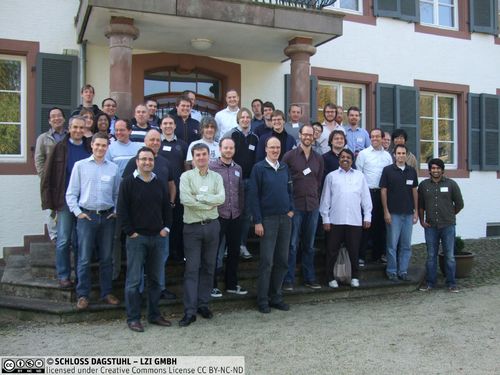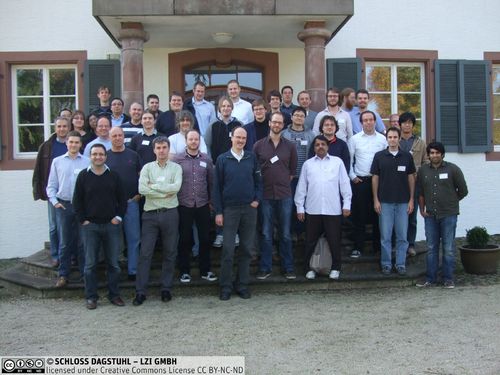Dagstuhl Seminar 12431
Time-of-Flight Imaging: Algorithms, Sensors and Applications
( Oct 21 – Oct 26, 2012 )
Permalink
Organizers
- James E. Davis (University of California - Santa Cruz, US)
- Bernd Jähne (Universität Heidelberg, DE)
- Andreas Kolb (Universität Siegen, DE)
- Ramesh Raskar (MIT - Cambridge, US)
- Christian Theobalt (MPI für Informatik - Saarbrücken, DE)
Contact
- Andreas Dolzmann (for scientific matters)
- Susanne Bach-Bernhard (for administrative matters)
Schedule
In recent years, Time-of-Flight (ToF) depth imaging technology has seen immense progress. Time-of-Flight imaging is based on measuring the time that light, emitted by an illumination unit, requires to travel to an object and back to a detector. From this time, scene depth and possibly additional information that can not be measured by traditional intensity imaging, is inferred. While early ToF cameras were merely lab prototypes to prove a concept, recent sensor designs are at the edge of becoming operative products for mass market applications. A wide range of research disciplines is able to benefit from reliable and fast depth imaging technology, such as computer vision, computer graphics, medical engineering, robotics and computational photography, to name a few. Easy availability of affordable depth cameras will open the door for many new applications. The commercial success of the Microsoft Kinect device -- a depth sensor based on an alternative measurement principle -- gives a first impression on this.
Currently, manufacturers of ToF systems mainly focus on sensor technology and on the design of cameras. Sensor design has seen great advancements, but the data delivered by the cameras remain challenging and are affected by many types of systematic distortions and difficult scene dependencies. ToF data are thus hardly usable out-of-the-box and it takes proper mathematical modeling and algorithmic processing to apply the data in practical imaging and reconstruction scenarios. Algorithm design for ToF imagers, however, is still in its early days and many challenges remain. In this seminar, we plan to discuss and extend the state of the art in ToF imaging algorithms and applications with leading researchers in the field.
Also, currently, there is little dialogue between researchers developing ToF algorithms and sensor designers. Therefore, the seminar also strongly supported the manufacturers in getting up to date with all relevant research results and, even more importantly, it offered the opportunity to establish long-term partnerships and research collaborations. We also believe that this stronger interaction will lead to more advanced sensor designs, as well as more powerful algorithmic solutions at the same time.
- Michael Balda (Metrilus GmbH - Erlangen, DE)
- Christopher Barsi (MIT - Cambridge, US)
- Erhardt Barth (Universität Lübeck, DE)
- Sebastian Bauer (Universität Erlangen-Nürnberg, DE)
- James E. Davis (University of California - Santa Cruz, US)
- Adrian Dorrington (University of Waikato, NZ)
- Martin Eisemann (TU Braunschweig, DE) [dblp]
- Peter Eisert (Fraunhofer-Institut - Berlin, DE) [dblp]
- Jürgen Gall (MPI für Intelligente Systeme - Tübingen, DE) [dblp]
- Marcin Grzegorzek (Universität Siegen, DE)
- Diego Gutierrez (University of Zaragoza, ES) [dblp]
- Uwe Hahne (SICK AG - Waldkirch, DE)
- Thomas Helten (MPI für Informatik - Saarbrücken, DE)
- Ivo Ihrke (Universität des Saarlandes, DE) [dblp]
- Slobodan Ilic (TU München, DE)
- Shahram Izadi (Microsoft Research UK - Cambridge, GB) [dblp]
- Bernd Jähne (Universität Heidelberg, DE)
- Andreas Jordt (Universität Kiel, DE)
- Thomas Kilgus (DKFZ - Heidelberg, DE)
- Kwang In Kim (MPI für Informatik - Saarbrücken, DE)
- Reinhard Klein (Universität Bonn, DE)
- Andreas Kolb (Universität Siegen, DE) [dblp]
- Daniel Kondermann (Universität Heidelberg, DE)
- Jens Kubacki (Mesa Imaging AG - Zürich, CH)
- Cornelia Lanz (TU Ilmenau, DE)
- Seungkyu Lee (SAIT - South Korea, KR)
- Damien Lefloch (Universität Siegen, DE) [dblp]
- Frank Lenzen (Universität Heidelberg, DE)
- Oisin Mac Aodha (University College London, GB) [dblp]
- Aditi Majumder (University of California - Irvine, US)
- Rahul Nair (Universität Heidelberg, DE)
- P. J. Narayanan (IIIT - Hyderabad, IN)
- Shohei Nobuhara (Kyoto University, JP) [dblp]
- Martin Profittlich (PMD Technologies - Siegen, DE)
- Ramesh Raskar (MIT - Cambridge, US) [dblp]
- Christian Schaller (Metrilus GmbH - Erlangen, DE)
- Andreas Schilling (Universität Tübingen, DE)
- Alexander Seitel (DKFZ - Heidelberg, DE)
- Christian Theobalt (MPI für Informatik - Saarbrücken, DE) [dblp]
- Julien Thollot (SoftKinetic-Brussels, BE)
- Gordon Wetzstein (MIT - Cambridge, US) [dblp]
- Giora Yahav (Microsoft Research - Haifa, IL)
- Ruigang Yang (University of Kentucky - Lexington, US) [dblp]
Classification
- computer graphics / computer vision
- artificial intelligence / robotics
Keywords
- Time-of-Flight sensors
- computer vision
- computer graphics
- robotics
- medical imaging
- 3D technology



